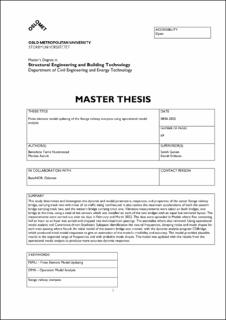| dc.description.abstract | The growing demand for public transportation and the need for trains at higher speeds highlights the importance of assessment and rehabilitation of train bridges. A challenge of rehabilitation is to restore or improve the structure without knowing the exact condition of the already existing bridge. This study determines and investigates the dynamic and modal parameters, responses, and properties of the easter Stange railway bridge, carrying track two with most of its traffic being northbound. The thesis also studies the maximum accelerations of both the eastern bridge carrying track two, and the western bridge carrying track one.
Vibration measurements were conducted to both bridges, one bridge at the time, using a total of ten sensors which was installed on each of the two bridges with an equal but mirrored layout. The measurements were carried out over six days in February and March 2022.
The data were uploaded in Matlab where flies containing from half an hour to an hour of data was sorted and cropped into individual train passings. The anomalies where also removed. Using operational modal analysis and Covariance-driven Stochastic Subspace Identification the natural frequencies, damping ratios and mode shapes for the train passings where found.
An initial model of the eastern bridge was created, with the dynamic analysis program CSiBridge, which produced initial modal responses to give an estimation of the model’s credibility and accuracy. The model provided plausible results in the expected range of frequencies and with probable mode shapes. The model was updated with the results from the operational modal analysis to produce more accurate dynamic responses.
In addition, the maximum accelerations of each train passing were compared to the requirement of standard NS-EN 1990. The study succeeded to update the model and additionally concludes that all the maximum accelerations on track two are within the standards of NS-EN 1990, while 36% of the maximum accelerations on track one are not. | en_US |
